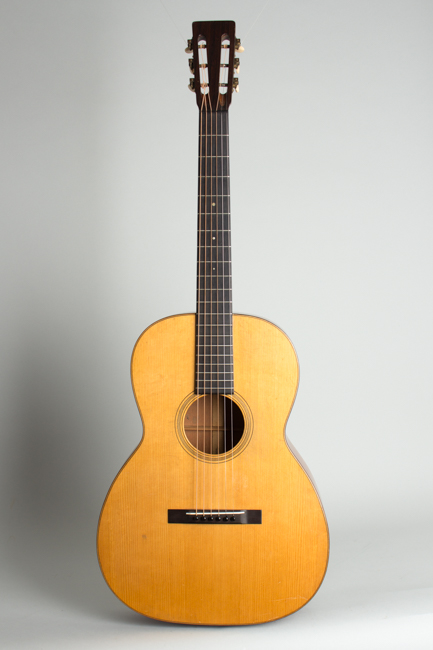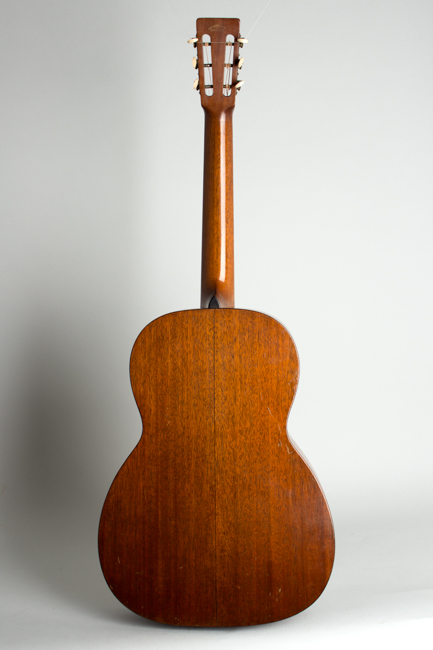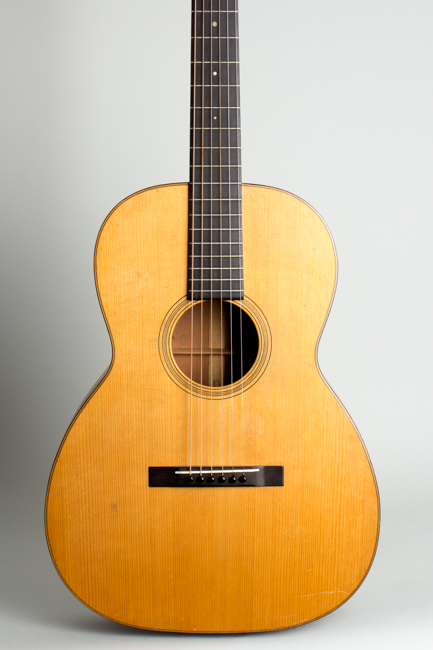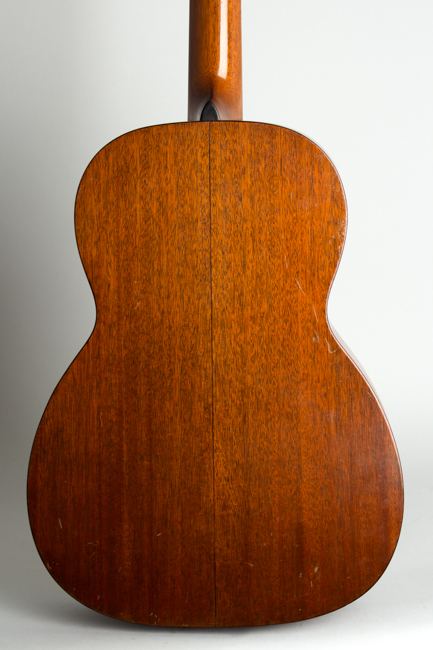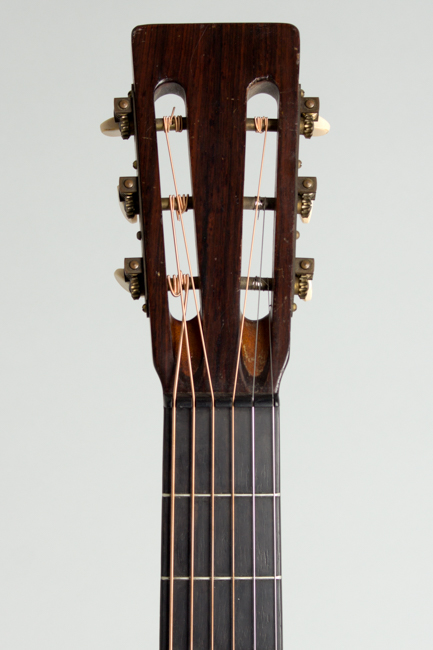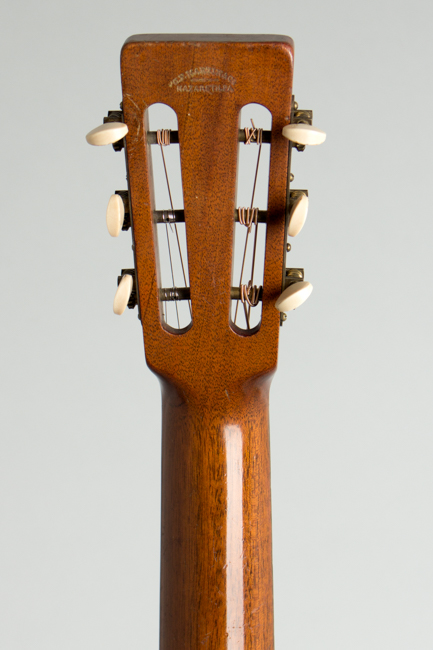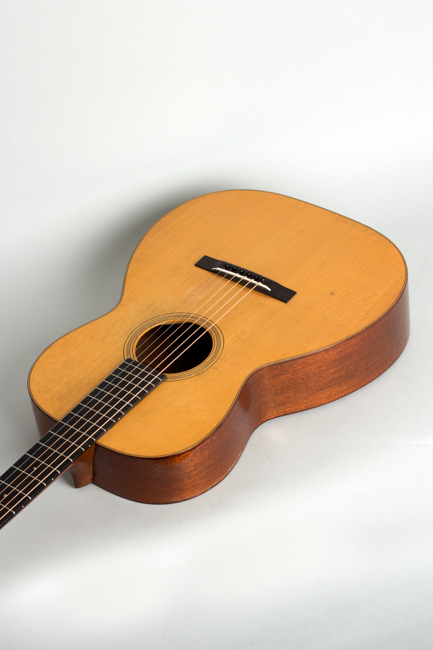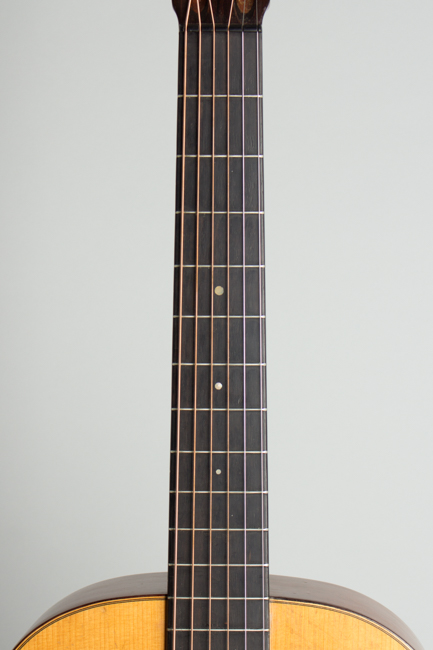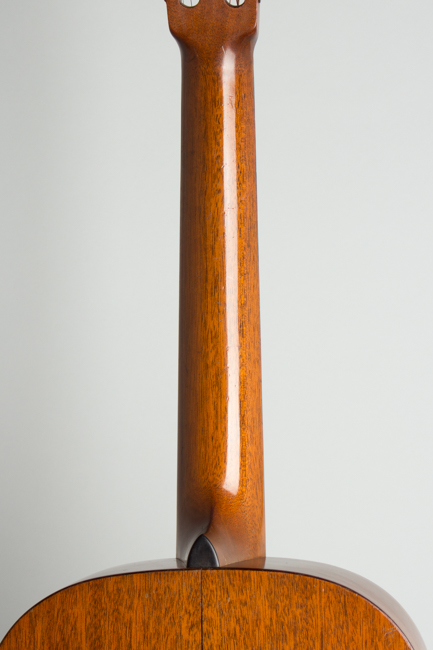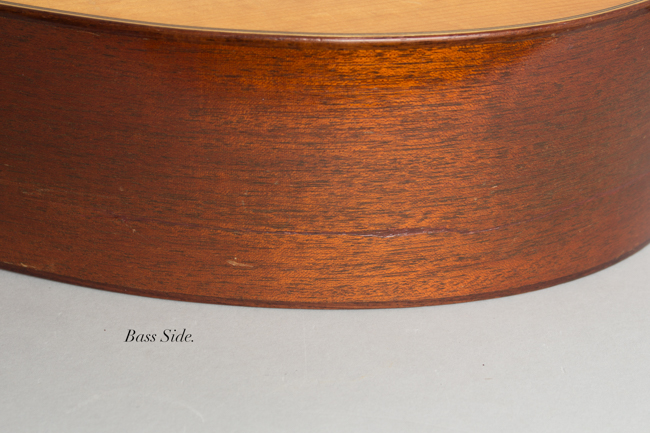C. F. Martin 000-18 Flat Top Acoustic Guitar (1927)
This item has been sold.
Item # 9155
Prices subject to change without notice.
C. F. Martin 000-18 Model Flat Top Acoustic Guitar (1927), made in Nazareth, PA, serial # 32867, natural finish, spruce top, mahogany back & sides, ebony fingerboard and bridge, black tolex hard shell case.
In 1927 the 000-18 was Martin's largest and most expensive mahogany-bodied instrument; all models above this were built with rosewood back and sides. It was also by this point a solidly steel-string guitar, which was a then recent development. Through the 1920s the Martin company gradually transitioned their line away from the traditional gut stringing, but up into the latter years of the decade many of the more expensive Brazilian rosewood guitars were still built in the older gut-strung pattern unless specifically ordered for steel.
This year the 000-18 had a list price of $50, up from $45 the year before. While that seems like nothing today, at the time it represented a considerable investment for many guitarists. Still, it was a real bargain in a professional quality instrument...at the time even a plain professional tenor banjo would run at least $100, and a Gibson L-5 archtop was $275!
The 15" wide 000-18 is a big-sounding guitar then and now, with plenty of definition even when played hard. This helped make it a popular choice for period vaudeville and early "hillbilly" entertainers, since it offered a lot of bang for the buck. As evidence of this, 1927 was a high production year for the model, with 201 being built.
This particular 12-fret 000-18 has survived the years very well and remains a very original guitar, despite having seen some play time. The top is bordered with wooden binding -- there was no plastic trim on the Style 18s yet! -- and wood sound hole rings. The unbound ebony fingerboard has three plain graduated-size dot inlays and the original bar frets. The bridge and nut are ebony and the Waverly tuners are unplated brass with grained ivoroid buttons.
With the very light, early steel-string bracing on the 15" wide featherweight 12-fret body, this guitar just sings, and the neck with a round-necked contour and wide ebony fingerboard is eminently playable. This is a very versatile guitar, responding extremely well to gentle fingerpicking and vigorous flatpicking. This would be one of the ultimate instruments for a truly authentic 1920s-style fiddle band, but really excels in any playing style. Simply a great guitar and a wonderful find in a 12-fret large-body, steel-string Martin now approaching its 100th birthday.
Overall length is 39 5/8 in. (100.6 cm.), 15 in. (38.1 cm.) wide at lower bout, and 4 in. (10.2 cm.) in depth at side, taken at the end block. Scale length is 25 1/4 in. (641 mm.). Width of nut is 1 7/8 in. (48 mm.).
Overall this is a very well-preserved guitar with some light wear for its age and relatively minor repair. The very thin original finish shows its share of dings, dents, and scrapes with a decent amount of pickwear into but mostly not through the lacquer on the top. There are some deeper scrapes along the back/side edge along the upper bass bout. The back of the neck has a number of shallow dings but no heavy wear.
There is one notable old repair, a long crack on the lower bass bout side running from near the endblock practically to the waist area. This is solidly sealed up with some rectangular cleats; it is not the neatest work, but is quite solid. This repair included only some light topical touch up, and the guitar has not had any overspray or finish work other than this. There are no other cracks anywhere.
The ebony bridge is a superb reproduction while the original very small maple bridgeplate is original and undisturbed...even the bridgepins are original. The original bar frets have been neatly re-crowned, the neck perfectly reset, and this is a truly very fine-playing guitar, quite powerful-sounding and extremely articulate even when pushed. We too rarely find steel-string Martins of this period that have not had more extensive wear and/or damage; this is far from a pristine guitar, but considering its age is better cared for than most. A lovely instrument -- simply superb-sounding and playing, in a newer hard case. Overall Excellent Condition.
In 1927 the 000-18 was Martin's largest and most expensive mahogany-bodied instrument; all models above this were built with rosewood back and sides. It was also by this point a solidly steel-string guitar, which was a then recent development. Through the 1920s the Martin company gradually transitioned their line away from the traditional gut stringing, but up into the latter years of the decade many of the more expensive Brazilian rosewood guitars were still built in the older gut-strung pattern unless specifically ordered for steel.
This year the 000-18 had a list price of $50, up from $45 the year before. While that seems like nothing today, at the time it represented a considerable investment for many guitarists. Still, it was a real bargain in a professional quality instrument...at the time even a plain professional tenor banjo would run at least $100, and a Gibson L-5 archtop was $275!
The 15" wide 000-18 is a big-sounding guitar then and now, with plenty of definition even when played hard. This helped make it a popular choice for period vaudeville and early "hillbilly" entertainers, since it offered a lot of bang for the buck. As evidence of this, 1927 was a high production year for the model, with 201 being built.
This particular 12-fret 000-18 has survived the years very well and remains a very original guitar, despite having seen some play time. The top is bordered with wooden binding -- there was no plastic trim on the Style 18s yet! -- and wood sound hole rings. The unbound ebony fingerboard has three plain graduated-size dot inlays and the original bar frets. The bridge and nut are ebony and the Waverly tuners are unplated brass with grained ivoroid buttons.
With the very light, early steel-string bracing on the 15" wide featherweight 12-fret body, this guitar just sings, and the neck with a round-necked contour and wide ebony fingerboard is eminently playable. This is a very versatile guitar, responding extremely well to gentle fingerpicking and vigorous flatpicking. This would be one of the ultimate instruments for a truly authentic 1920s-style fiddle band, but really excels in any playing style. Simply a great guitar and a wonderful find in a 12-fret large-body, steel-string Martin now approaching its 100th birthday.
Overall length is 39 5/8 in. (100.6 cm.), 15 in. (38.1 cm.) wide at lower bout, and 4 in. (10.2 cm.) in depth at side, taken at the end block. Scale length is 25 1/4 in. (641 mm.). Width of nut is 1 7/8 in. (48 mm.).
Overall this is a very well-preserved guitar with some light wear for its age and relatively minor repair. The very thin original finish shows its share of dings, dents, and scrapes with a decent amount of pickwear into but mostly not through the lacquer on the top. There are some deeper scrapes along the back/side edge along the upper bass bout. The back of the neck has a number of shallow dings but no heavy wear.
There is one notable old repair, a long crack on the lower bass bout side running from near the endblock practically to the waist area. This is solidly sealed up with some rectangular cleats; it is not the neatest work, but is quite solid. This repair included only some light topical touch up, and the guitar has not had any overspray or finish work other than this. There are no other cracks anywhere.
The ebony bridge is a superb reproduction while the original very small maple bridgeplate is original and undisturbed...even the bridgepins are original. The original bar frets have been neatly re-crowned, the neck perfectly reset, and this is a truly very fine-playing guitar, quite powerful-sounding and extremely articulate even when pushed. We too rarely find steel-string Martins of this period that have not had more extensive wear and/or damage; this is far from a pristine guitar, but considering its age is better cared for than most. A lovely instrument -- simply superb-sounding and playing, in a newer hard case. Overall Excellent Condition.
